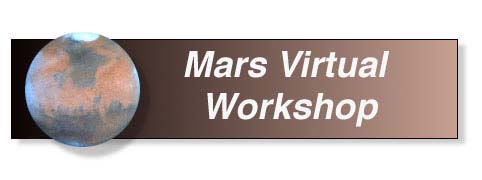

Click on the small image to see it full sized.
As we check in at the hotel, some of us began to put faces with names we
had met only online.
There is much anticipation as participants arrive in Washington. Two
teachers from each of the fifty states has been selected to attend the
Mars Teacher Training Workshop.
 |  |  |
 |  |  |
 |  To the left, Cheick Diarra addresses group; and on the right an I.B.M. executive addresses the group. |  |
|
Kathy Walsh of IBM explains the "Virtual City" |  | Janet Caldon, IBM discusses advances in technology |  |
 |  |  |
 |  | ...and everyone did a lot of chatting |
 | After the reception at I.B.M., participants were shuttled to the National Academy of Sciences |  |
| Donna Shirley, Pathfinder project manager, welcomed the participants to the discussion on Mars exploration and the future of NASA in space exploration. |  |
In 1976 the Viking spacecraft investigated the Martian surface. A claw was unilized to sample the surface and a mini-laboratory analyzed the soil for evidence of life. The results were inconclusive, but as Chris pointed out, we had reached across space to another planet and grasped out for understanding its importance as a harbinger of life. This critical event changed his life, and he has worked to understand life's origins here and in space.
Probes could be launched more frequently and for less by the start of the next millenium. His vision was apparent as he teased Donna Shirley about moving up her schedule to return a sample from Mars to Earth by 2002.

Questions were taken and many focused around the importance of preserving the planet during exploration. All three presenters emphasized NASA's efforts to make information available via the Internet to schools and children.
A resolution was read honoring Carl Sagan on the 20th anniversary of
Viking's landing and recognizing his work for our understanding of our
place in the cosmos.
[ Mars Conference Home | Agenda | Technical Overview | Live Conference Area ]


